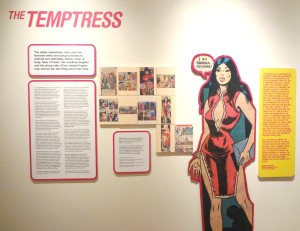New exhibit examines portrayal of Asians
In Japan, lore featuring figures, such as an old martial arts master who lives on a mountain far away from civilization, abound. Picture it: his beard long from age, his head bald from wisdom and his body strong from endless training. This mysterious old figure speaks to no one. Only the chosen one who dares to venture into the foreign mountains of Asia can learn this old man’s secrets. But in order to gain the master’s trust, the chosen individual must follow the master’s strange riddles and tasks without question.

Fitting the mold · Marvels & Monsters seeks to analyze the way Asians have been portrayed in popular culture. One of the American portrayals of Asian women has been that of a Temptress, as pictured above. – Kalai Chik | Daily Trojan
Descriptions such as the above contribute to the agelong image of the guru archetypes. Along with the guru, other Asian characterizations are examined in the new Japanese American National Museum exhibition: Marvels & Monsters: Unmasking Asian Images in U.S. Comics, 1942-1986.
The new exhibit contains tales of mystical beings in American comic books. Despite its origin in South Asia, the guru archetype has evolved into the epitome of plot devices in modern media. The exhibit contains the most extensive repository of Asian and Asian-American characters in American comics, featuring cultural studies scholar William F. Wu’s own personal collection. From the United States’ fear of the foreign unknown to the fascination for Eastern education, Marvels & Monsters effectively analyzes Asian representation during four tumultuous periods of American social unrest. Notably, the exhibit triumphantly shines light on the dark ages of American history and raises awareness to end the media’s deceptive perpetuation of stereotypes.
The exhibition focuses on eight common archetypes: Guru, Brain, Temptress, Lotus Blossom, Brute, Alien, Kamikaze and Manipulator. Each trope is placed in context, incorporating commentary and analysis from Asian-American comic book writers such as Greg Pak and poets such as Ken Chen. What the exhibit lacks in space, it makes up for with incredible yet shocking images of Asian archetypes. Visitors can come face-to-face with the full-size cutouts of nostalgic scenes exemplifying the preservation of misrepresentations, which, in reality, continue to persist today. A piece called “Shades of Yellow” provides a gradient of Asian skin tones found in comics emphasizing the stark yellow Pantone faces in comparison to a highlighter yellow wall.
One of the most interesting parts of the exhibit is the inclusion of the Lotus Blossom and the Temptress, both illustrating the fetishization of Asian woman as sexual objects. Underneath the large Lotus Blossom title lies the violent image of a damsel who is moments away from death at the hands of her lover, hurt from her betrayal. These representations of both Asian men and women highlight the misguided beliefs behind these archetypes and expose the consequences of negative portrayals of Asians. Though many contemporary scholars argue the Western male exploitation of Asian women was beneficial to both sides, the exhibit argues the opposite. Analysis provided by David Henry Hwang explains that the Lotus Blossom archetype was clearly “born of sexual and economic exploitation” where the Western males capitalized on “economically underprivileged” Asian female bodies.
This past weekend, William Wu, the collection donor, traveled to Little Tokyo to tour the exhibit. An acclaimed sci-fi author and cultural studies scholar, Wu is no stranger to American fiction’s portrayal of Asians and Asian-Americans. An avid comic book reader growing up, Wu found himself captivated yet disgusted by the distorted depiction of Asians in print media. Along with the help of friends and family, he amassed an assortment mainstream comic books with a multitude of distorted renditions of Asians. Initially, Wu inspired Jeff Yang’s idea for the exhibit after Wu donated his comics to the New York University Fales Library and Special Collections.
The traveling exhibition displays many stereotypes illustrated in some of the most well-known Marvel and DC comic book series such as Iron Man and Batman. And though many of these same negative portrayals of Asians and Asian-Americans have become more subtle, they remain very prevalent in mainstream media. Arguably, these fictional images continue to fuel the mistrust in the sensitive American mind as more and more of the younger generation are exposed to harmful portraits of Asians and Asian-Americans painted by years of fear and social unrest.
Even though the villain Mandarin is not depicted as Asian in some mainstream adaptations of Iron Man, he retains his Fu Manchu moustache and is still called “The Mandarin.” Clearly, depictions of stereotypes originally intended as war propaganda can lead to long-term, unintended social repercussions. Even in more peaceful times, the constant circulation of stereotypes only serves to steer America in the path of social chaos and destruction.
Marvels and Monsters: Unmasking Asian Images in U.S. Comics, 1942-1986 is on display at the Japanese American National Museum until Feb. 9. Perhaps the old master will descend from his obscure location to teach people the secret to bringing peace and harmony: raising cross-cultural awareness.
Follow us on Twitter @dailytrojan
